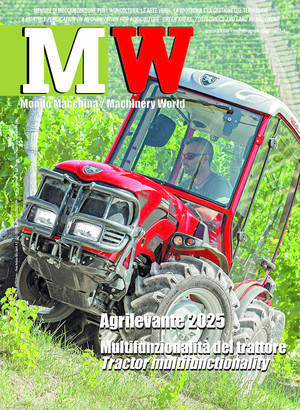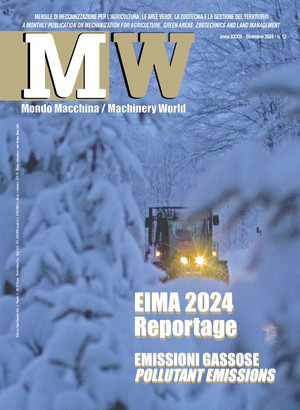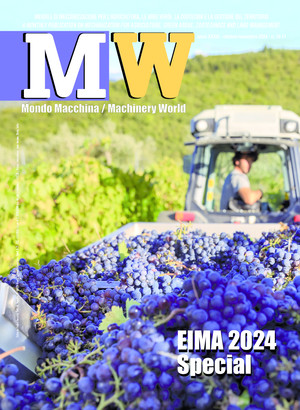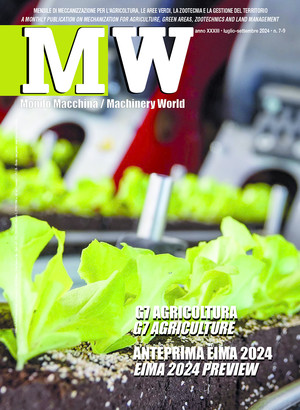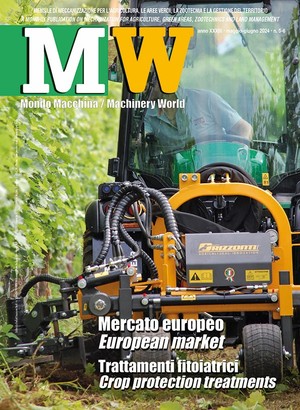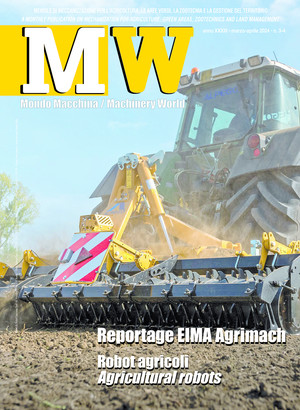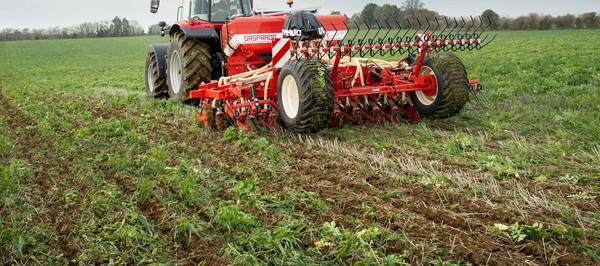
The role of mechanization in regenerative agriculture
Maintaining the current health of agricultural soil is now no longer sufficient; it is urgent to restore its optimal chemical, physical and biological balance, which has been compromised by decades of intensive use. This restoration must prioritize environmental sustainability, while strengthening our planet's resilience to climate change
several decades, in several areas of global importance, some popular cereal species, primarily corn and rice, have been grown as monocultures. While this agronomic choice can be justified for rice due to its particular development characteristics, namely growth in submersion for a good part of its cycle, good practice has always recommended including corn cultivation in a suitable rotation that can preserve the chemical, physical and biological balance of the soil.
Due to the simultaneous disappearance of solid fertilizers of organic origin, primarily manure, mainly due to the cessation of the use of straw as a basic material for bedding in livestock farms, the supply of nutrients for crop development has shifted towards synthetic fertilizers and when available, livestock waste in an eminently liquid form. It has not, however, had much of an effect on the shortage of organic matter in agricultural land, which very quickly, in many cases, found itself below the critical threshold of 2%, a level considered a serious wake-up call regarding its state of health.
Conservative agriculture, first of all, and regenerative agriculture are now aimed precisely at "curing" agricultural soil, which has long been depleted of the components that guaranteed its delicate balance. This purpose is integrated with other important objectives and is substantially oriented towards protecting the environment and its resilience to climate change.
Therefore, it was a question of implementing a large number of cultivation activities, partly rediscovering and relaunching those already known for some time in the light of technical progress and partly introducing new solutions, without forgetting to optimize productivity, without which an agricultural practice that ensures a profitable income could not continue to exist.
Starting with crop rotation, practices such as intercropping, green manure, and cover crops have become an integral part of the cultivation plans of those farms that are attentive not only to conservation but, above all, to improving the fertility of their land and have an eye for the environment, understood as a complete ecosystem capable of significantly influencing the health of our entire planet.
This note, along with two others published in this issue of Mondo Macchina—Machinery World, aims to provide a brief overview of the most recent mechanization solutions available for modern cultivation that respect these new agronomic standards.
Crop rotation. It improves the fertility and physical structure of the soil, ensures a more rational use of water and mineral nutrients, prevents the spread of pathogens and weeds and helps control erosion.
Crop rotation can be practiced in a closed cycle, which is a predefined pattern that is generally repeated every 2-5 years, or with a free alternation, which maintains the basic principles unaltered and follows patterns applied from time to time according to the organizational and economic needs of the farm.
Similarly, crops can be classified as preparatory, improving and impoverishing. As the term suggests, preparatory crops can provide the following crop with a certain quantity of elements necessary for their development: in this category, we find, for example, beet, sunflower, tomato, potato and tobacco.
Enhancing crops can restore the soil's most correct physical, chemical and biological conditions: lawn grasses, fodder legumes and grain legumes guarantee this action.
Finally, impoverishing crops are those that negatively affect the soil: wheat (soft and durum), barley, triticale, rice, rye, oats and ryegrass belong to this category.
Crops belonging to these three groups must, therefore, be harmoniously alternated in the rotation, with the addition of other practices such as grass, either as a set-aside solution (land at rest) or for the production of fodder. This contributes to improving the water balance and increasing fertility in poor soils.
While mechanization in monoculture is substantially univocal, in the sense that the same machines are always used, in the great majority of rotations, crops are alternated that require different types of equipment for one or more processes.
In fact, some machinery, such as that used for primary and secondary soil preparation, can be profitably employed for almost all the crops included in the rotation, bearing in mind, however, the modern tendency to reduce the intensity of cultivation in favor of minimum or even no-tillage.
Vice versa, other equipment is more specific to fully satisfy agronomic needs: for example, considering only cereal crops, sowing in rows differs depending on whether wheat, barley or corn is being planted; in the latter case, the work must be "precision" work, with models that differ significantly from universal seeders. More machinery is needed if the crop rotation includes grass for fodder production, as the equipment for haymaking is specifically designed for that purpose.
Product harvesting also requires attention: for cereals and other crops, the combine harvester is the machine of choice, but it must be set up with dedicated headers, taking into account some particularities, such as the flexible section mowing bar, to be used for soybeans.
Intercropping. Intercropping, which is the simultaneous cultivation (for all or part of the crop cycle) of different species in the same plot, can be considered a radicalization of crop rotation. This practice can hopefully have important synergistic effects. This is a well-known agronomic solution in the hobby gardening sector, but it has recently been rediscovered at a professional level, too. Perhaps the most famous case is the cereal-legume intercropping, the former being competitive in the uptake of mineral nutrients from the soil and against weeds. At the same time, the latter is well known for biological nitrogen fixation, carried out at the level of the root nodules by symbiotic bacteria of the genus Rhizobium. One factor to emphasize in this type of intercropping is the structural support provided by the grasses, which, thanks to their ascending behavior, are able to reduce the loss of legume harvests, caused mainly by their prostrate and easily flattened growth habit.
Another option is mixed intercropping, i.e., combining a tree crop with a herbaceous one. In addition to providing a windbreak barrier, the tree species guarantees an additional source of income in areas that are not fully cultivable for herbaceous crops, for example, due to excessive slopes. The most popular combinations in this context are undoubtedly vines and olive trees associated with fodder crops.
There are also known cases of intercropping between two tree crops, such as olive and lemon; in this case, the centuries-old olive trees, with their expansive foliage, protect the lemon trees from the wind, reducing the risk of the spread of "mal secco" (a disease that causes the leaves to shrivel and die). Furthermore, the partial shade reduces sunburn and creates a climate that decreases the lemon's water consumption. Intercropping can be permanent if the crops are continuously present on the same land or temporary if they are present for only part of their vegetative cycle.
many cases, the mechanization of intercropping requires specialized equipment for the type of intervention, which must, in any case, respect the needs of both crops; this is not a given, especially for exclusively herbaceous combinations. From this point of view, reducing the intensity of working the soil to a solution that allows minimum disturbance of the soil, i.e., direct sowing, favors the coexistence of the crops.
The Biochar
It is vegetable charcoal obtained by the slow pyrolysis (also called"carbonization") of different types of biomass, especially agricultural by-products such as prunings, corn or wheat stubble, rice husks,dry foliage, etc.
This is a combustion process that takes place in the absence or limited presence of oxygen at atmospheric pressure and temperaturesof 400-700°C, in which syngas (which has a calorific value equal toLPG) is produced at the same time, which is aimed at producingheat through subsequent combustion, and a liquid fraction, bio-oil,consisting mainly of water, phenolic compounds and anhydrous sugars.
Biochar has recently found numerous applications: for water treatment, thanks to its remarkable porosity, which makes it effective infiltering and adsorbing heavy metals, pathogenic organisms and potentially toxic organic or inorganic contaminants; in animal husbandry, as a feed additive, able to increase metabolic yields, favoring digestion and absorption of nutrients, but also for the management of animal waste, reducing odors and preventing the outflowof sewage; in the cement industry, as an additive that guaranteesgreater chemical stability, low conductivity and limited flammability.
However, it is undoubtedly in agricultural cultivation that Biochar hasbeen most successful. When incorporated into agrarian soil, it hasan effective soil-improver action: its high porosity increases the retention of water and nutrients, which, in this way, remain availablefor the crops for longer.
More specifically, it is able to improve soil fertility, enhancing varioustypes of residues and by-products (especially of plant origin); increasethe rate of water retention and macro- and micro-nutrient elements;reduce soil acidity, increasing its pH; create an environment favorable to the proliferation of soil microbial biomass; promote the nitrogen fixation process, and store carbon in the soil, even for longperiods.
The so-called "carbon removal" is, in fact, the main added value ofBiochar in its function as a soil improver because it can keep largeamounts of carbon fixed in the soil for very long periods of severaldecades. In fact, during pyrolysis, a significant amount of plant-basedcarbon (photosynthesized from atmospheric CO2) remains boundin the Biochar. Although a fraction of this carbon exists in inorganic form and is lost in a few weeks or is slowly mineralized over theyears, as much as 90% is in a stable form and remains in the soilfor a very long time. This characteristic has led to Biochar being considered the basis of the most promising NET (Negative EmissionTechnologies), or considered "carbon neutral" or even "carbon negative," and therefore suitable for mitigating climate change.


